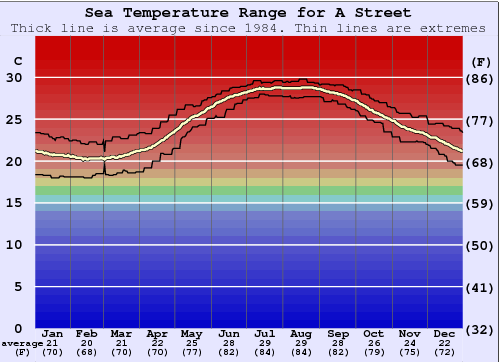A Street Water Temperature and Wetsuit Guide
(North Florida, USA)
- Forecast
- Maps
- Live
- Weather State
- Spot Information
Today's A Street sea temperature is 80 °F
(Which is slightly cooler than normal)
| Mean: | 82 °F | ||||||||||||||||||||||||||||||||||||||||||||||||||||||||||||||||||||||||||||||||||||||||||||||||||
|---|---|---|---|---|---|---|---|---|---|---|---|---|---|---|---|---|---|---|---|---|---|---|---|---|---|---|---|---|---|---|---|---|---|---|---|---|---|---|---|---|---|---|---|---|---|---|---|---|---|---|---|---|---|---|---|---|---|---|---|---|---|---|---|---|---|---|---|---|---|---|---|---|---|---|---|---|---|---|---|---|---|---|---|---|---|---|---|---|---|---|---|---|---|---|---|---|---|---|---|
| Range: | 79 °F to 84 °F | ||||||||||||||||||||||||||||||||||||||||||||||||||||||||||||||||||||||||||||||||||||||||||||||||||
| Statistics for 17 Jun (1981–2005) | |||||||||||||||||||||||||||||||||||||||||||||||||||||||||||||||||||||||||||||||||||||||||||||||||||
Today, many surfers would wear a summer wetsuit.
A hot and sunny day, feeling like 86 °F even after we account for wind, and very warm water temperature (79 °F) too at A Street. Surfers may need a thin summer wetsuit or at least a rash vest to block the UV.
(click thumbnails to expand)
Below is a graph of Historical Sea Surface Temperature for A Street. This has been derived from analysis of two decades of oceanographic satellite measurements of nearby open water. We have calculated the average water temperature variation around the year as well as the extremes that have been observed on each date.

All of the graphs for the surf breaks presented on Surf-Forecast.com are on the same scale to enable comparison between locations around the world.
A Street water temperatures peak in the range 28 to 30°C (82 to 86°F) on around the 24th of July and are at their lowest on about the 11th of February, in the range 18 to 22°C (64 to 72°F). Year round warm water temperatures at A Street climb to their warmest in the fourth week of July. Even then a rash vest and board shorts should be fine for surfing at any time of year. A Street water temperatures are lowest in the second week of February. Surfers should use a 2mm long sleeve shorty or a 3/2mm spring wetsuit if the wind is up.
Actual sea surface water temperatures close to shore at A Street can vary by several degrees compared with these open water averages. This is especially true after heavy rain, close to river mouths or after long periods of strong offshore winds. Offshore winds cause colder deep water to replace surface water that has been warmed by the sun. Air temperature, wind-chill and sunshine should also be considered before deciding on the kind of wetsuit needed to stay warm when surfing at A Street. Refer to our detailed weather forecasts for this information.





















 Nearest
Nearest